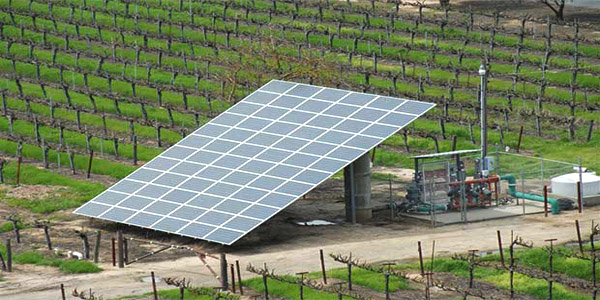In recent years, supportable agriculture has gained significant attention due to the need for efficient and environmentally friendly farming practices. One such innovation that has emerged is the solar drip irrigation system.
As water lack becomes a growing challenge and the need to reduce carbon emissions gains prominence, creative solutions are being explored.
Contents
- 1 Solar drip irrigation
Solar drip irrigation
The solar irrigation system is a method of sending water directly to the plant roots using solar-powered pumps.

Why is drip irrigation important?
It is the best order way of carrying water and nutrients to crops. It provides water straight to the plant’s root zone in the proper amounts and, at the right time, ensures that each plant receives what it requires, when it requires it, to grow helpfully.
What is a solar drip irrigation system?
The Solar Electric Light Fund (SELF) organization has combined with the International Crops Research Institute for Semi-Arid Tropics to develop a system that combines solar-powered water pumps with drip tubes.
Drip irrigation is an agricultural solar irrigation method in which water is given directly to the root zone of plants using applicators that are orifices, emitters, and perforated pipes operated under low pressure and positioned either on or below the ground’s surface.
What are the parts of a solar irrigation system?
These are the main parts.
- A surface or submersible water pump (generally integrated into one unit with an. electric motor)
- A distribution system and storage tank are needed for irrigation water.
- Solar generator: Array of panels to produce electricity
- A pump controller
- Solar tracking system
Advantages of Solar drip irrigation
These are the advantages.
- It Reduces dependence on foreign oil and fossil fuels. Renews clean power available every day of the year, even on cloudy days, produces some power.
- Virtually no keeping as solar panels last over 30 years.
- It gives a clean alternative to fossil fuels and enables the growth of irrigated agriculture with low carbon.
- In areas with no access to energy, they give to rural electrification and reduce energy costs.
- Solar can heat water, power homes and buildings, and even cars.
- Pollution-free and causes no greenhouse gases to be released.
- It can be installed nearly anywhere, from a field to a building.
Solar Drip Irrigation Work Process
The following work is as follows.
Solar Panels: Photovoltaic (PV) solar panels have been installed to harness the sun’s light and convert it into electrical energy.
Solar Pump: The direct current (DC) electricity developed by the panels is used to power a solar pump. The pump pulls water from a water origin, such as a well.
Water Filter process: Before the water enters the irrigation system, it passes through a filtration technique to remove waste.
Distribution Grid: The filtered water flows through a network of pipes or tubes provided with drip emitters.
Watering Plan: The irrigation system can program with a watering plan based on the specific water needs of different crops.
Solar Power Storage: Excess solar energy developed during the day can be stored in batteries during the night.
What is the use of solar drip irrigation?
Water and fertilizers can be given to plants throughout the six-month dry season, allowing large plots of vegetables year-round.
Conclusion
Solar irrigation offers a manageable and well-ordered solution for agricultural water command. It minimizes water wastage, reduces energy use, and motivates water and soil care.
It enables precise water delivery to plant roots, better crop health, higher yields, and improved quality.
FAQs
Yes.
20-30 years or more.
These systems use small pumps powered by solar panels to deliver precise amounts of water directly to the roots of crops, lowering water waste and growing crops.
In an SPIS system, electricity is created by solar PV panels and used to operate pumps to remove, lift, and give irrigation water.
In the mid-2000s, the Solar Electric Light Fund (SELF) organization partnered with the International Crops Research Institute for Semi-Arid Tropics and devised a combination of solar-power water pumps with drip tubes.